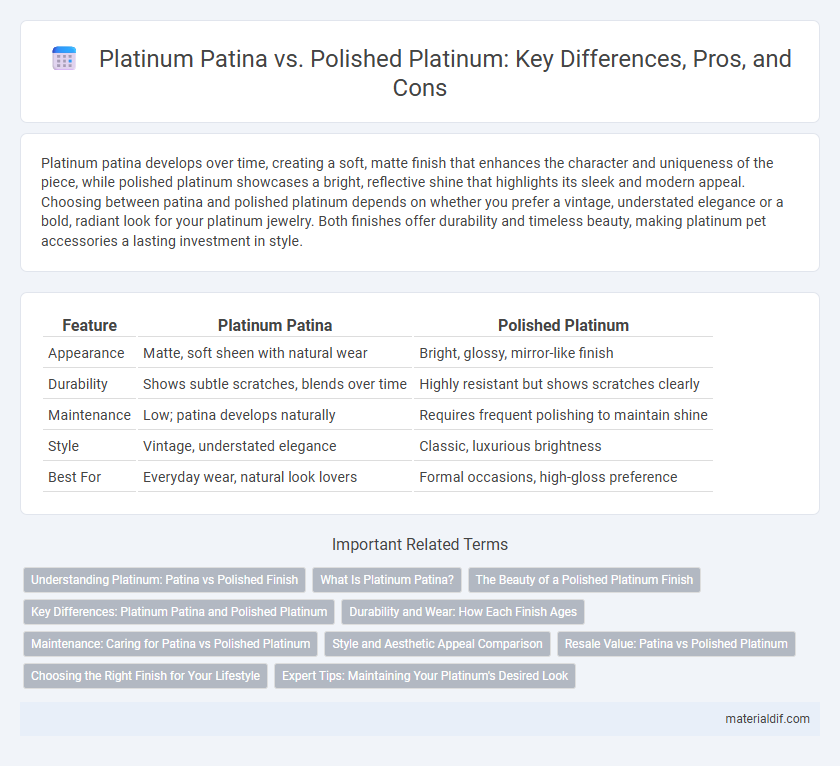Platinum patina develops over time, creating a soft, matte finish that enhances the character and uniqueness of the piece, while polished platinum showcases a bright, reflective shine that highlights its sleek and modern appeal. Choosing between patina and polished platinum depends on whether you prefer a vintage, understated elegance or a bold, radiant look for your platinum jewelry. Both finishes offer durability and timeless beauty, making platinum pet accessories a lasting investment in style.
Table of Comparison
| Feature | Platinum Patina | Polished Platinum |
|---|---|---|
| Appearance | Matte, soft sheen with natural wear | Bright, glossy, mirror-like finish |
| Durability | Shows subtle scratches, blends over time | Highly resistant but shows scratches clearly |
| Maintenance | Low; patina develops naturally | Requires frequent polishing to maintain shine |
| Style | Vintage, understated elegance | Classic, luxurious brightness |
| Best For | Everyday wear, natural look lovers | Formal occasions, high-gloss preference |
Understanding Platinum: Patina vs Polished Finish
Platinum patina develops a soft, satin-like texture that enhances the metal's natural durability while creating a unique, vintage appeal preferred in antique or heirloom pieces. Polished platinum offers a high-gloss, reflective surface that accentuates the brilliance and purity of the metal, ideal for modern and high-end jewelry designs. Understanding the choice between patina and polished finishes helps in selecting platinum jewelry that matches personal style, maintenance preferences, and the desired aesthetic impact.
What Is Platinum Patina?
Platinum patina is a natural, matte finish that develops on platinum jewelry over time due to tiny surface scratches and wear, giving pieces a soft, understated glow. This textured appearance contrasts sharply with the bright, reflective shine of polished platinum, which is achieved through regular buffing and polishing. The patina is highly valued for its unique character and vintage appeal, often enhancing the depth and subtlety of platinum's color.
The Beauty of a Polished Platinum Finish
A polished platinum finish showcases the metal's natural brilliance with a smooth, reflective surface that enhances its luxurious appeal. This finish highlights platinum's resistance to tarnish and corrosion, maintaining its radiant shine over time. Unlike platinum patina, which offers a matte and vintage look, polished platinum delivers a timeless elegance ideal for fine jewelry and watches.
Key Differences: Platinum Patina and Polished Platinum
Platinum patina develops a soft, matte finish over time due to natural wear, highlighting its vintage appeal and texture, whereas polished platinum features a high-gloss, mirror-like surface that emphasizes sleekness and modernity. Patina enhances the metal's character by subtly smoothing scratches and preserving a unique, aged look, while polished platinum requires regular maintenance to retain its reflective shine. Choosing between patina and polished platinum depends on the desired aesthetic: timeless sophistication with patina or bold brilliance with polished surfaces.
Durability and Wear: How Each Finish Ages
Platinum patina develops a natural, soft matte finish over time, enhancing its durability by disguising scratches and daily wear, making it ideal for those who prefer a vintage or understated look. Polished platinum maintains a shiny, mirror-like surface initially but requires more frequent maintenance to prevent visible scratches and preserve its reflective quality. Both finishes exhibit exceptional strength and longevity, with patina aging gracefully through subtle texture changes, while polished platinum demands regular care to sustain its vibrant brilliance.
Maintenance: Caring for Patina vs Polished Platinum
Patina on platinum develops a soft, matte finish that requires gentle cleaning with mild soap and a soft cloth to preserve its unique texture without removing the natural aging effect. Polished platinum, characterized by its high-shine surface, demands regular polishing and more frequent professional maintenance to prevent visible scratches and maintain its reflective brilliance. Both finishes benefit from avoiding harsh chemicals and abrasive materials, but patinated platinum offers a lower-maintenance option for those who prefer a subdued, vintage look.
Style and Aesthetic Appeal Comparison
Platinum patina offers a sophisticated, matte finish that enhances its vintage charm and subtle elegance, appealing to those who prefer understated luxury. In contrast, polished platinum delivers a high-gloss, mirror-like shine that emphasizes brilliance and modernity, attracting individuals who favor a sleek and striking appearance. Both styles highlight platinum's durability and prestige but cater to different aesthetic preferences, from timeless refinement to contemporary boldness.
Resale Value: Patina vs Polished Platinum
Platinum with a natural patina often holds higher resale value due to its unique matte finish that develops over time, signaling authenticity and wear. Polished platinum, while visually striking with its high-gloss shine, may require frequent maintenance and can show scratches more easily, potentially decreasing its resale appeal. Collectors and buyers tend to favor the patina finish for its character and durability, which can translate into greater long-term investment value.
Choosing the Right Finish for Your Lifestyle
Platinum patina offers a subtle, matte finish that develops a unique character over time, making it ideal for those who prefer a low-maintenance, vintage look. Polished platinum provides a bright, reflective surface that suits individuals seeking a classic, high-shine appearance and frequent professional polishing. Selecting between patina and polished platinum finishes depends on your lifestyle habits, desired aesthetic, and willingness to maintain the metal's appearance.
Expert Tips: Maintaining Your Platinum's Desired Look
Maintaining platinum's desired look requires understanding the differences between patina and polished finishes; patina develops naturally over time, offering a soft, matte appearance, while polished platinum showcases a bright, reflective shine. Experts recommend gentle cleaning with a soft cloth and mild soap for polished surfaces, avoiding abrasive materials that could scratch the metal, and using professional services for re-polishing to restore brilliance. To preserve patina, minimize exposure to harsh chemicals and store platinum jewelry separately to prevent unwanted scratches that disrupt the matte texture.
Platinum Patina vs Polished Platinum Infographic

 materialdif.com
materialdif.com